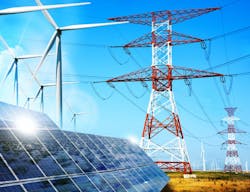Partnership Searches for Grid Resiliency Policy that Can Work Across the States
A new research project intends to scrutinize US public policy on grid resiliency with an eye toward creating a model approach that can be applied at the state level.
Protect Our Power, a bipartisan advisory panel, and the Vermont Law School’s Institute for Energy and the Environment also will look at the role of distributed energy resources and microgrids.
“We’re trying to find models that can work at the state level, but it may be a menu of approaches that can be applied in different states,” said IEE Executive Director Kevin Jones in an interview.
The researchers hope to create a policy framework to enhance grid resiliency as cyberthreats grow. Alongside that, the partners will zoom in on physical threats that are large in scale and long in duration, such as extreme weather, terrorist attacks and cascading power outages.
Key objectives of the partnership include identifying ways regulators can make timely decisions and utilities can recover costs associated with improving grid resiliency. Policies and incentives related to microgrid investment and deployment figure to play an important role.
State legislatures and state regulatory commissions already are grappling with issues related to both utility ownership and cost recovery of microgrids.
No rallying concept
“These are current issues in many states and standard models have not emerged that the states (or groups) can rally around,” said Paul Feldman, Protect Our Power technical director, in an interview.
There has been a lot of news, marketing, public relations campaigns and political lobbying, touting how distributed energy resources and microgrids can enhance the utility grid, said IEE’s Jones.
While they may do so, more components and more network connections also makes for a more technically complex systems environment. Changing conditions in any one system component — a PV panel, a circuit, switch-gear or transformer, for example — can ripple out and affect microgrid and utility grid performance.
“…standard models have not emerged that the states (or groups) can rally around.” — Paul Feldman, Protect Our Power
That has important implications when setting out to create policies that enhance energy and grid resiliency, Jones said.
Such technical factors, along with economics, laws and regulations, have to be considered and rigorously examined when creating state level policy models and applying them nationwide, Jones said.
Cost are likely to be significant for critical grid resiliency improvements made nationwide. Bringing clarity and predictability to the process will ensure that costs are shared equitably among all stakeholders, according to Protect Our Power.
Disparate grid resiliency models — and more to come
In carrying out its research work with Protect Our Power, IEE intends to review and leverage connections to traditional, power industry policy-making resources, as well as explore and assess recent and new alternatives.
“There are many and disparate models under consideration, and the expectation is that more models will surface before there is any real consensus — if at all. There are also emerging models related to microgrids participating in BES (Bulk Electricity System) and distribution reliability markets that will be of increasing importance,” Feldman said.
IEE plans to deliver its initial report to Protect Our Power by December 2018. The research team will then turn its findings and recommendations into draft model state legislation.
“We’re essentially coming up with a report that we will deliver to Protect Our Power by the end of the year, along with a policy framework that will move us into stage 2, during which we’ll complete a working model come spring next year. By the end of spring, or in summer, we expect to have a framework to bring out and promote at the state level,” Jones said.
Track news about grid resiliency by following Microgrid Knowledge on Twitter @MicrogridNews.
